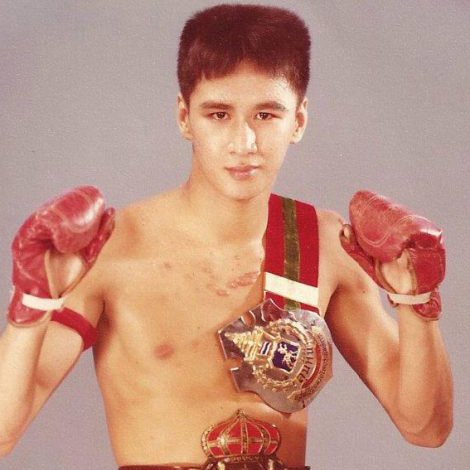Search the Community
Showing results for tags 'Technique'.
-
Hello everyone this is my first post on here! I will be staying for one month here in Chiang Mai to train Muay Thai. I am having trouble choosing a gym and after browsing the forum I’ve concluded that the best way to pick a gym is to go and train there for a day. My main question would be should I go to afternoon or morning sessions to best gauge the feeling of the gym? My budget is a bit constrained and it’s around $25usd for a day pass and $12 for a session pass so I’d like to save as much money as possible. I’ll be training both sessions once I commit to a gym. The gyms I’m considering are: Manop, Manasak, HongThong, Sit Thailand, Lanna, Santai Any information or advice about any of these gyms or training in general at all is appreciated, thank you!
-
I started late, 25 yrs old. I have recently found Sylvie's videos interviewing Angie and while that is a huge inspiration for me as someone now a few months into training, I have found the real hook that kept me coming back to class religiously is the impact of Muay Thai on my relationship to my body. I pass fairly well when I am conforming to western femininity but I actually gravitate towards tom/butch expression (undercut, little makeup, "men's" cloths) despite being MTF. For my whole life, and especially the last few years during transition I have had basically hypervigilance/hyper fixation surrounding my body and how its being perceived/gendered and how I exist in space. Surrendering to the grind/burn of Muay Thai has been one of the biggest non-medical transition tool for reframing my relationship to my body from one centered on the perceptions of others, to one centered around learning how to assert myself in space and exercise balance and autonomy over my body. I have a lifetime of sharpening ahead of me but I have found a great deal of relief and reward in the distance I have come so far. As I become more at home in my body I am able to understand how my natural tendencies match up to the various subdisciplines/systems of Muay Thai and serves as a salient anchor for these parts of myself I want to develop in my regular life, and for getting past traumas. Making this post to share this experience, as after the fact I thought it was very ironic that this thing that is so good for specifically trans mental health (in my opinion) is socially and sometimes legally off limits to us. How does my experience compare to yours? Do you know any trans fighters that have had similar or different experiences?
- 7 replies
-
- 4
-
-
-

-
- therapy
- philosophical
-
(and 3 more)
Tagged with:
-
Kali (Pekiti Tirsia to be more specific) is the only other martial art I have practiced for a significant time (about 8 years or so). It's a Filipino art that is not very "sportified" and is based on the use of blades and impact weapons (empty hands training is done, too though but its based on the same patterns and concepts as the blades). I found it really interesting how similarities between different arts pop up, especially with the more traditional styles. There is so much that sounded very much familiar to me in the Muay Lertrit sessions. Things that are either very much the same as I learned in Kali or at least follow the same principle. There is this thing about "let them try to strike you but make them pay every time" that we also did a lot. Directly counterattacking instead of blocking is a central concept there. Stuff like parrying a punch with a move that, if done well, is supposed to strike the opponent in the same move as it parries their punch. Or making someone who uses a leg kick on you pay by not only blocking with your own shin but dropping your knee on their ankle while doing so, very similarly to what the general demonstrates in that one session. Also I've watched the session with Gen Hongthonglek a few times and only the last time it suddenly occurred to me that the way he uses fakes, delayed timing and counters is actually very similar to how I used to do sparring with the stick in Kali when I was more experienced. I'd typically move back to keep range (I'm a very tall guy with long arms) and would constantly weave my stick in front of me or throw my opponent off with some weird position kind of like Gen does with his feet before he lands his big kicks. This kinda stuff is really fascinating to me. Sure there are differences between arts but often there are also overlaps or concepts that can be applied to other arts as well. Did you have similar experiences? PS: Of course there are differences, too: For example Kali teaches you to give not getting hit (at all if possible) top priority because an opponent could always carry a weapon even if you don't see it right away so every hit might be very dangerous. Thats something I have to practice to overcome a bit in Muay Thai where the opponent is guaranteed to not have a weapon and getting hit is not actually a mistake in principle.
- 13 replies
-
- 7
-

-

-

-
- technique
- muay thai library
-
(and 1 more)
Tagged with:
-
So a good friend made this meme a while back and its always resonated with me. The idea being dont pass over the basics and fundamentals for fancy technique. This meme always becomes so relevant when someone in combat sports wins by spinning anything. Not because Im against spinning techniques, but because of how they always seem to jump the line so to speak past tried and true (possibly boring to students?) fundamental techniques with high percentages of landing. For context: (its not muay Thai I know, but it does effect me teaching muay Thai, so...) Raymond Daniels winning his fight in mma this last weekend. If you havent seen it, look up Bellator's social media. Curious to hear people's opinions, reactions, etc.
-
I'm a bit inspired by Coach James's recent thread about kids "fighting" (they're sparring, but James is bothered by it and in his mind used the word fighting in his title, which I think is significant), but also because I just was watching some hard sparring at my gym here in Thailand. Here's the set up. In the West, we tend to have this "holier than thou" attitude toward "technical sparring" over "hard sparring," usually accompanied by some kind of credit to how "technical and light" sparring in Thailand is. Okay, sure, I've seen very little sparring among Thais in which they're trying to hurt or knock each other's heads off (I have seen some), whereas I have seen that kind of sparring in Thailand but usually when one or both of the people participating are not-Thai. This said, when Thais spar with shinpads and gloves, it's not "light." The word for sparring in Thai len cherng, literally means to "play techniques." That's the point, and usually the spirit of it. But it's not "light" in the sense that the West tends to characterize it as for their own uses and purposes. It is more "lighthearted," but the actual power of strikes and intention is well over the 60% that I'd qualify as "going light." I was watching two sets of sparring at my gym yesterday. The first couple were both not-Thai. One guy was from India, the other from Italy. The Indian guy always goes too hard, as judged by me for what's appropriate for practice. But he's never told by the coaches to turn it down, which means they see a purpose to how hard he strikes. He also tires easily. And they never put him with someone who is close to a fight, because they know he goes this hard. The Italian guy has way more experience than the Indian guy and, while he got battered pretty good by hard leg kicks and punches in the first round and a half, he took the lead with clinch and knees to "win" the sparring - as if it were a fight, judged by others. The thing is this: the punches and kicks were 100%. The emotional stress and intention was 100%. And the guy who goes too hard, by gassing and ultimately being bettered in the end, his disappointment was 100%. All of those elements are important for learning how to fight. You have to deal with real stress. You have to deal with the consequences of coming out too hard, too early, if you don't have the stamina to keep it going. You have to learn how your power overwhelms someone and then doesn't. And likewise, the Italian guy has to learn that you can't only practice going in and having everything controlled for you. I was pretty impressed by the way he handled it, honestly, and I'm not very generous in things I like about this guy. As an important note, while nobody was told to take their power down, there were shinpads, large gloves, a referee and spectators to break the two men when things were too heated or stagnant, or to stop the time early if needed. It's still being supervised, just not interfered with very much. The next couple were two Thai boys, both about 14-16, same weight as each other but a gulf in experience. One has been training and fighting since he was 8 and surely 100+ fights, the other a handful of years with only 20 or so fights. One loves to go backwards (the experienced one) and gets yelled at for it, the other likes to come forward and strike pretty hard. They both kicked and punched less than 100% power, but not far below that. There were exchanges when the power would go up, but then it would come back down. There was never any "danger" throughout that match, unlike the other one. The biggest difference, however, was the emotional charge. There were moments when the two Thai fighters were amped up a bit, the dominance was real. But they weren't trying to hurt each other. They were trying to dominate each other and shut the other down. It wasn't like that with the non-Thais; there was an element that felt not in control with them, an emotional derailment that felt dangerous... although the Thai men who sat around the ring to watch found it incredibly entertaining. So here's my point: there is a purpose to hard sparring. There is purpose to "technical" sparring. There is an art to both, and I think both are required for the development of a fighter. But what's "light" about Thai sparring is not the power of strikes; it honestly is in the "asshole factor" of emotional energy put into the sparring itself. It's a lack of control that makes hard sparring dangerous or not worthwhile, not the power itself. Stress is an important training tool. Disappointment is a training tool. Gassing out is an important training tool. To only ever advocate for some kind of pantomime sparring robs fighters of those tools. This was Jame's original post discussion that lead to these thoughts:
-
One of Sylvie's posts about clinch got me thinking about the differences in technique and method in Thailand vs the west. It's interesting how some things may be effective in the West but are not at all effective in Thailand. Part of this is due to relative inexperience in western countries, for both trainers, fighters, and officials. I also think part of it has to do with the influence from MMA, at least in America. Often amateur and even pro fighters will compete against someone with an MMA background who is competing in Muay Thai for experience, though it isn't their primary sport. The judges and commissions often do not score according to Thai rules, so that changes the game significantly. One big difference I have noticed is in cutting weight. You cannot safely do a water load/sodium cut the same way you could do in America. This is due to both the heat in Thailand and the likelihood that your trainer will want you to train until just a day or two prior to the fight. Granted, you don't really need to as it is so easy to sweat in the heat. It is still a major difference, no less. There are many differences from a technique perspective, but one that sticks out is that your block has to be at a much more narrow angle in Thailand. Less experienced fighters tend to have more superfluous movement in their kick, so it tends not to be as direct. It seems this has caused fighters in the states to both use and instruct a wider and less condensed block. What are some major differences you have noticed?
-
I'm posting my article on the pros and cons of training clinch barehanded (the Thai way) or with gloves (the way we fight), creating a space for longer form conversation of our experiences. I found benefits to both, but lately I've turned to gloves for reasons outlined in the article. Should You Train Clinch With Gloves or Barehanded?
-
I've written before about the troubles I've had with a kind of Style (the post takes a while to load, lots of GIFs), and being forced into a style that wasn't "me", or at least that I had a really hard time bringing forward. I just wasn't an evasive, tricky, or dodge-y person. It wasn't until I discovered that there was a different style, a forward, space-eating style that I was set more free. I remember the beginning of realizing this was something that Andy Thomson said: "There is not one Muay Thai, there are 1,000s. Each person has their own Muay Thai." The yesterday I wrote about the Things I'm Working On and a lot of them have to do with my style, and how to best bring it out. These things involve body punches, overhands, clinching hips in, taking space, not rushing. I wanted to post here because a lot of us feel like we want to measure up to "a" Muay Thai. We want to do it "right". There definitely are right and wrong ways to do things, but there is not the one way to do a particular thing. You don't need to be a fighter to think about style. What is your style, and what are you doing to pursue it?
-
Just trying to put together some drills for my training, some that I can use with either a partner on Thai Pads or on the Heavy Bag. For example: Pyramid Drill for kicks - left round once, right round once, left round twice, right round twice, etc, etc, all the way to 10 and back down What other drills do you guys like to do? For any technique. Thanks guys !
-
The above is a pretty awesome recent fight between Thanonchai, famous for his never-say-die attitude, and Phet-U-Tong. What's pretty interesting to me about this fight, and Sylvie and I talked about this when watching it, is how Thanonchai responds to the common righty-lefty tactic Phet-U-Tong uses here. You see it from Yodsanklai (lefty), and Sittichai (lefty) used it against Roosmalen in his recent Glory fight - but it's available to righties too, when facing strong left hand punchers. Basically, lots of rear-leg high kicks pinning and punishing the power hand. Phet-U-Tong a few rounds in really starts trying to pin Thanonchai's power left cross, and Thanonchai just tries punching through it. The stubbornness of Thanonchai makes the fight really tense. The eventual result, once Phet-U-Tong starts to tire is dramatic.
- 2 replies
-
- 7
-

-
- Thanonchai
- Rajadamnern
-
(and 1 more)
Tagged with:
-
We were practising kicks the other day and my trainer said something among the lines: "If you step outside/pivot on your standing foot enough there's no need to lower/straighten the kicking leg arm, it's better to keep your guard up when kicking than risking a counterhit". What is your kicking leg hand/arm position in kicks? Does it changes with different kicks? Have you noticed different outcomes with different positions?
-
On The Muay Thai Guy's podcast, I heard a strength and conditioning coach say that lack of engagement in the glutes when doing kicks can lead to knee and low back pain. I've exper low back pain since starting Muay Thai and I've had the problem with lack of glute engagement in running too that led to other injuries. The question: does anyone know of a good article or tutorial that will teach me how to engage the glutes when kicking?
-
Hi, Travelling soon to Thailand and have free time for training in Bangkok,anyone knows which gym has good clinch techniques cause I want to improve mine... Last year have been training in Luktupfah and Penang96 both good training but not really in to the better clinch work(or teaching it) Thanks ;-)
-
Wondering if anyone saw this fight and could comment on Rory's elbow? He landed some elbows, but they didn't really seem to hurt Robbie or cut him. Also, he was attempting to counter jabs and straight crosses with elbows and was often missing. If you didn't see the fight, I was wondering if any of the pros on here could comment on range and elbows, and where you find elbows most effective. Thanks!
- 5 replies
-
- fight discussion
- fight
-
(and 3 more)
Tagged with:
-
Before I started muay thai, I fight in sanda rules ("chinese kick-box", also with throws and leg grabs). I was always afraid to kick the body, because in sanda we rather use our feet, not shins, when we kick, and it was so painful when I accidentaly kicked my opponent's elbow. And my friend's foot broke actually by this: she kicked, and her opponent used elbow as a guard. I started muay thai, I've learnt to kick with my shins, and slowly I started to be "brave" enough to kick to the body. It's still painful when I kick an elbow, but my shins became harder And now... We had sparring at training (2 weeks ago), my training partner was a beginner man. He didn't know how to defense, or catch leg, he just moved instinctively. I teeped him - he pushed forward his elbows ---> extreme pain in my foot. Next day I couldn't stand on my injured foot, so I went to a hospital. X-Ray, diagnosis: IV. metatarsal bone is broken. I can't walk, just with crutches, it means a month "rest". I hate it, I'm worried if it will be normal again, etc... So, okay, I never experienced this, when I spar or fight with a non-starter opponent. I never used my elbow to defend a teep. But really... You can't strenghten up your feet. And I don't want to be afraid to use teeps. How can you avoid this?
- 12 replies
-
- injury prevention
- injury
- (and 6 more)
-
Hello everyone, not sure if any of you have ever noticed anything similar in your training, but lately I've been experiencing the following situation in my training and I'm not sure if this is simply a normal part of trying to learn something new or if perhaps I may be having issues with some mental block or whether I'm experiencing a bit of burnout from training too much/not enough rest: I'm usually training 5-6 days a week, with the sparring sessions being later at night, usually the last class of the evening at 8:30pm, and those are the only sessions that I can go to since I work during the day time (wake up at 5am, finish work at 4:30 in the afternoon, start training at 6:15 in the evening). I've been trying to force myself to stay for the sparring classes even when I'm already tired since I would like to get more practice before my trip to Thailand in 4 months, however, I find that I'm becoming slower, more hesitant, and have difficulty incorporating new techniques into my sparring, instead end up using the same techniques over and over, it's almost like I can't beat my reflex in favor of a different technique; I practice different techniques in shadowboxing but it doesn't seem to be translating into practical application...I'm not really sure if this is simply because of not enough sparring practice, or if there's some kind of mental training that I could be doing that would make it easier for me to apply what I know, or am I simply doing more harm than good by forcing myself to stay for sparring when I'm already tired. If you have ever noticed any of those things in your training and if you have any suggestions for my issue it would be much appreciated. Thank you
Footer title
This content can be configured within your theme settings in your ACP. You can add any HTML including images, paragraphs and lists.
Footer title
This content can be configured within your theme settings in your ACP. You can add any HTML including images, paragraphs and lists.
Footer title
This content can be configured within your theme settings in your ACP. You can add any HTML including images, paragraphs and lists.


